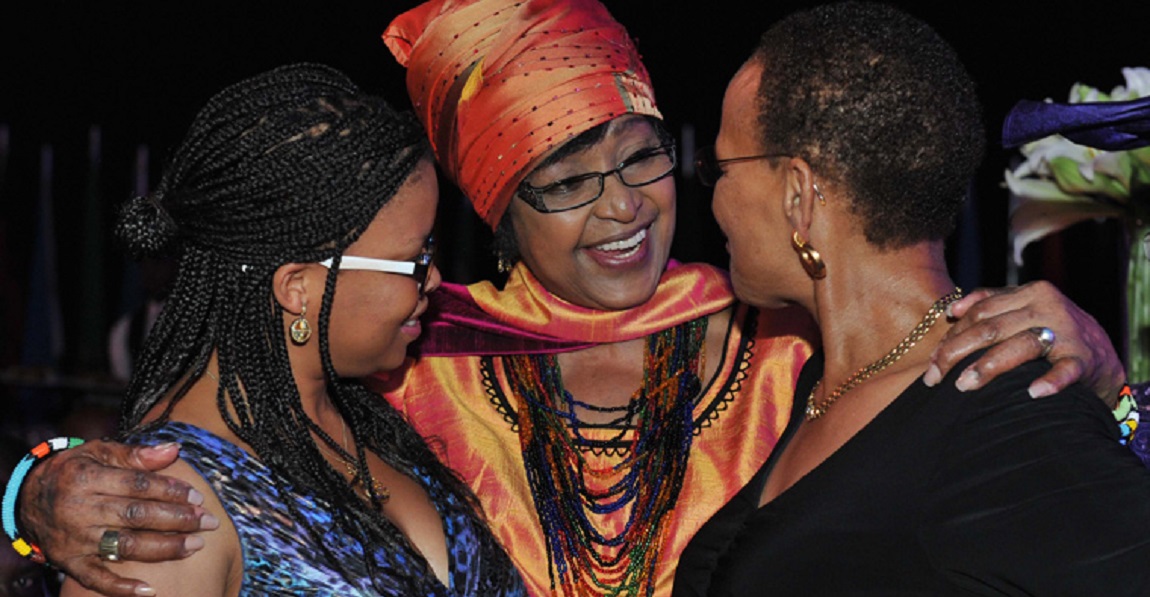
The nation mourns the death of the prolific revolutionary and struggle icon Nomzamo Winifred Madikizela-Mandela, who died on Monday, 2 April at the age of 81. The legacy that Winnie Madikizela-Mandela leaves behind is rich and intricate, and her place in our country’s struggle for political liberation is indisputable. This is despite that it is marked by controversy and demonisation by the media, and that her history is inextricably linked to her husband Nelson Mandela. Here is an outline of the contributions she made and the hardships she suffered in the name of freedom.
A political education that started long before Nelson Mandela
Born on September 26, 1936 in Transkei to history teacher father and science teacher mother, Winnie was fortunate enough to have been educated before the enforcement of Bantu education. She passed her standard eight with distinction and went on to study at a Methodist mission school at Qumbu called Shawsbury. There, she matriculated and emerged as a person with exceptional leadership qualities. Under the tutelage of teachers who were all Fort Hare graduates, she began to become more politicised.
In 1953, a young Winnie moved to Johannesburg where she was admitted to Jan Hofmeyr School of Social Work. She quickly secured herself the position of medical social worker at the Baragwanath Hospital, making her the first qualified, Black member of staff to fill that post. Her interest in national politics continued to grow. Winnie lived in a hostel connected to the hospital and shared a dormitory with Adelaide Tsukudu, the future wife of former African National Congress (ANC) president, Oliver Tambo. She discovered that Tambo happened to be from Bizana and that they were members of the same extended family.
Winnie was already politically interested and involved in activism long before she met Mandela. She was particularly shaken by her research as a social worker in Alexandra Township to establish the rate of infantile mortality, which stood at 10 deaths for every 1 000 births.
Winnie weds Nelson Mandela
A 22-year-old Winnie met and fell in love with Nelson Mandela. The two married on 14 June 1958 in Bizana. That same year, in October, she took part in a mass action which mobilised women to protest against the Apartheid government’s infamous pass laws. This protest in Johannesburg followed a similar action that had taken place in Pretoria in August 1956. It was organised by the president of the ANC Women’s League Lilian Ngoyi and Albertina Sisulu, amongst others. Police arrested 1000 women. The arrested women decided not to apply for immediate bail, but to rather spend two weeks in prison as a sign of further protest. A pregnant Winnie saw first-hand the squalid conditions of South African prisons and her commitment to the struggle only intensified. Eventually, Mandela and Oliver Tambo were called to arrange their bail, and the ANC raised money to pay the convicted women’s fines. This event thrust Winnie into the public eye beyond the shadow of her husband, but also alerted national security to her potency as a voice of political dissent.
In 1961, nine days after the police murdered 69 people during a Pan African Congress (PAC) anti-pass demonstration at Sharpeville, they arrested Mandela leaving Winnie all by herself in what would become a trend in their marriage.
Inspiration – and attack – on her inner circle
Mam’ Winnie listed Lillian Ngoyi and Helen Joseph (the only two women accused in the Treason Trial), Albertina Sisulu, Florence Matomela, Frances Baard, Kate Molale, Ruth Mompati, Hilda Bernstein (the first Communist Party member to serve on the Johannesburg Council in the 1940s), and Ruth First as some of the people who inspired her and were her trusted confidantes. Her inner circle became consistently smaller as many people gain her trust as allies, only to turn on her as state spies.
State target
The apartheid government made Winnie the consistent target of abuse. Her children were expelled from every school and had to eventually be sent to school in Swaziland. Her home was constantly raided, visits to her husband in prison cancelled. Winnie’s movement was restricted and her employers hounded by the police making sure she was fired from job after job. Despite this, Winnie continued to keep active and organised assistance for political prisoners.
Winnie was was eventually arrested in 1969 under Prime Minister John Vorster’s 1967 Terrorism Act, No 83. She was jailed for 17 months. In first 200 days, she had no contact with another human being except her interrogators, including Major Theunis Jacobus Swanepoel, a notorious torturer. In her concrete cell were three thin bug-infested and urine-stained blankets, a plastic water bottle, a mug, and a sanitary bucket without a handle. A bare electric light bulb burned constantly, robbing her of any sense of night or day.
After interrogation and torture – where Winnie was kept awake for five days and five nights without respite – she acquiesced to tell them whatever they wished to hear. Winnie’s trial finally began on 1 December 1969. After many complications, Winnie’s release was finally secured. She had spent 17 months in prison with 13 of those in solitary confinement and was never convicted at the end of it.
In May 1973 Winnie was arrested again for meeting with another banned person, her friend and photographer for Drum magazine Peter Magubane. She was handed a 12 month sentence at Kroonstad women’s prison, but released after six months.
The mother of the struggle
Winnie was 1970s – a time of unrest amid the South African youth who had become volatile. Steve Biko’s Black Consciousness Movement in 1969, the all-black South African Students’ Organisation (SASO) changed the dynamics of the struggle which was taken up the youth. Winnie became the symbolic mother to this student movement. In the 1976 student uprising, Winnie joined Dr Nthatho Motlana to establish the Soweto Parents’ Association. The two worked tirelessly to assist with youth and parents who had been arrested, injured, or killed in the riots. For this the police held her in custody yet again for five months, eventually releasing her in December 1976 without charge. In January 1977, she was served with yet another five year banning order.
The apartheid government banished Winnie to Brandfort for eight years in 1977. Winnie was not demoralised and continued to flout racist apartheid legislation and would not to be cowed by unjust segregationist laws. According to opinion polls taken during her first two years in Brandfort, she was the second most important political figure in the country after Zulu chief Mangosuthu Buthelezi. When she was allowed to return home in the 80s, Winnie continued to help those she saw as vulnerable. She established a place for disenfranchised youth to feel at home, organise, and socialise in the form of the Mandela United Football Club (MUFC) – which eventually led to her downfall.
Infamy and demonisation
History and circumstances forced the couple – Nelson and Winnie Mandela – to move in starkly opposite directions. Mandela and his Robben Islanders became more academic and statesman-like during their years cut-off from grassroots politics, but Winnie was forced to become a soldier on the ground. She suffered decades of police intimidation and harassment, emotional brutalisation of having had her family torn apart and her closest friends betray her, imprisonment and banishment. Winnie developed combative defences against a world that was unfailingly hostile to her. She was prone to drink and violent behaviour – and took a militant and violent approach to the struggle. Winnie’s most infamous speech was in an address in Munsieville when she said: “together, hand in hand, with our boxes of matches and our necklaces we shall liberate this country.”
The MUFC went awry and gained a reputation in Soweto for operating with impunity as a kind of vigilante mafia under the tutelage of their coach, Jerry Richardson (he later exposed himself as a police informer during the Truth and Reconciliation Commission). Stories about kidnappings, assaults, and torture at the hands of the MUFC emerged. One of the most famous stories of kidnapping was of Stompie Seipei, a 14-year-old activist who fell out with MUFC. He went missing from his home, was beaten, and ultimately murdered with a pair of gardening shears. Winnie and her associates in the MUFC were put on trial for the murder. Winnie was eventually cleared of the murder but sentenced to five years in prison on four counts of kidnapping and one year as an accessory to assault. But the shadow of Stompie followed her.
Abandoned in the new South Africa
In the dawn of the free South Africa, Mandela was released from prison. Winnie had brief stints in the ANC government as the head of social welfare and then the ANC Women’s League but she separated from her husband in 1992 and then formal ANC politics soon after. Controversy clouded her with financial irregularities on her receipts, the rumours of an affair with her deputy, and she could never truly shirk her involvement with MUFC. Winnie’s legacy is within the ANC as a liberation movement and not the ANC as a government.
Forever the activist
Even though her formal involvement in the ANC was over, Winnie continued to champion causes that she believed in. She travelled to Zimbabwe in June 2000 to express solidarity with the war veterans taking over white farms, and in July 2000 she donned a t-shirt with the words “HIV positive” and joined the protest that demanded free anti-retrovirals for sufferers of HIV.
Rest in power Winnie Mandela. South Africa will forever remember your unwavering call for freedom and justice in the stories of our struggle.








